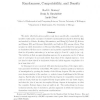Free Online Productivity Tools
i2Speak
i2Symbol
i2OCR
iTex2Img
iWeb2Print
iWeb2Shot
i2Type
iPdf2Split
iPdf2Merge
i2Bopomofo
i2Arabic
i2Style
i2Image
i2PDF
iLatex2Rtf
Sci2ools
STACS
2001
Springer
2001
Springer
Randomness, Computability, and Density
We study effectively given positive reals (more specifically, computably enumerable reals) under a measure of relative randomness introduced by Solovay [32] and studied by Calude, Hertling, Khoussainov, and Wang [6], Calude [2], Kuˇcera and Slaman [20], and Downey, Hirschfeldt, and LaForte [15], among others. This measure is called domination or Solovay reducibility, and is defined by saying that α dominates β if there are a constant c and a partial computable function ϕ such that for all positive rationals q < α we have ϕ(q) ↓< β and β − ϕ(q) c(α − q). The intuition is that an approximating sequence for α generates one for β whose rate of convergence is not much slower than that of the original sequence. It is not hard to show that if α dominates β then the initial segment complexity of α is at least that of β. In this paper we are concerned with structural properties of the degree structure generated by Solovay reducibility. We answer a natural questio...
Related Content
| Added | 30 Jul 2010 |
| Updated | 30 Jul 2010 |
| Type | Conference |
| Year | 2001 |
| Where | STACS |
| Authors | Rodney G. Downey, Denis R. Hirschfeldt, André Nies |
Comments (0)

